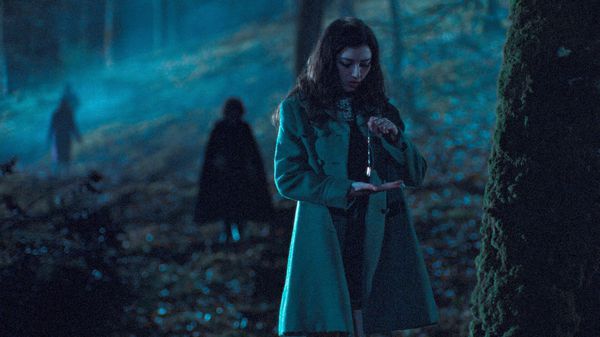Eye For Film >> Movies >> Bitten (2023) Film Review
Bitten
Reviewed by: James Gracey

Convinced she has only one more day to live, Françoise and her friend run away from their convent boarding school and hitch a lift to a party in a vast chateau in the middle of the woods. Here, amid decadence and occultist dalliances, she encounters various lost souls, including a sullen party guest who claims to be a vampire, as she struggles with fiery, prophetic visions and a sense that time is running out.
Set in 1967, La Morsure is a melancholy and mesmerising period piece, with notes of Rollin, Breillat, Argento and Hadzihalilovic. There are also echoes of Poe’s The Masque of the Red Death, as Françoise (Léonie Dahan-Lamort) finds herself among a throng of revellers, none of whom appear to share her feelings of impending doom. Writer-director Romain de Saint-Blanquat sets the story in an in-between space, reflecting the threshold Françoise stands upon, but despite her intentions, seems hesitant to cross. Like Rosaleen from The Company of Wolves and Sarah from Labyrinth, we follow Françoise as she embarks on her transition from childhood to adulthood. Events unfold over the course of one day and night, and a recurring theme of opposites and contrasts intertwining is present throughout: holy/sacrilegious, day/night, alive/dead, young/old.
The story begins on Ash Wednesday, which marks the first day of Lent, a significant date in the Christian calendar and a period of spiritual discipline, prayer, self-denial. Françoise, however, is intent on denying herself nothing, she wants to revel, to experience pleasure and pain, love and loss. The party she and Delphine (Lilith Grasmug) attend is for Mardi Gras/Carnival, a time of excess, indulgence and irreverence. A note containing the location of the party is passed around between the girls during mass, like a secret, forbidden rite within a rite.
Filtered through a lens of 1960s psychedelia, the film is visually striking, notably the scenes in the forest after the party, as the shadows of the moonlit trees take on a life of their own, stretching over the characters like a giant shimmering web. The sumptuous score by Emile Sornin imbues proceedings with a rich, Gothic ambience. Other arresting moments come when Françoise experiences her inflamed visions of death, consults her crystal pendulum for advice, and glimpses a be-fanged Christophe (Maxime Rohart) for the first time. While the figure of the vampire here is used to reflect Françoise’s dilemma – what it is to be alive and yet not truly live - her encounter with Christophe, which is tinged with tension and culminates in a chapel engulfed by flames, ultimately leads her to achieve agency and decide upon her own path and fate.
A meditation on the twilight realm between childhood and adulthood, and all the wonder and terror contained therein, La Morsure unfurls as a lamentation on the loss of innocence. While not as overtly fantastical as, say, The Company of Wolves, Pan’s Labyrinth or Lemora, de Saint-Blanquat’s film has moments of Gothic fancifulness and is an atmospheric and visual delight.
Reviewed on: 28 Aug 2023















